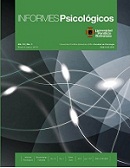Evidencia de la interferencia en el procesamiento de representaciones gustativas y visuales en la memoria operativa
Contenido principal del artículo
Resumen
El propósito de este estudio es evaluar la interferencia de las representaciones gustativas y visuales en el procesamiento de la memoria operativa. Participaron del experimento 48 sujetos argentinos universitarios cuya edad promedio fue de 23,27 años (de=4,286 años). Se empleó un diseño cruzado para realizar comparaciones intra-sujetos. Se determinó como variable independiente a la congruencia del estímulo y se definieron tres niveles: estímulos congruentes, incongruentes y controles. Se determinaron como variables dependientes al número de aciertos y al tiempo de reacción. El experimento consistía en observar la pantalla de una computadora en la que se presentaba una imagen mientras se degustaba un estímulo gustativo. La consigna requería identificar lo más rápidamente posible el estímulo gustativo. Los resultados mostraron una menor interferencia stroop en el nivel de estímulos congruentes que en los niveles de estímulos incongruentes y controles dado que se produjeron menores errores y menores tiempos de reacción. En futuras investigaciones se recomienda estudiar la interferencia stroop intermodal gustativa y visual por palabra y comparar los resultados con la interferencia stroop intermodal gustativa y visual por imágenes.
Referencias
Baddeley, A. (1995). Working memory: the interface between memory and cognition. En D.L. Schacter & E. Tulving (Eds.), Memory sistems (pp. 351-368). Cambridge: The MIT Press.
Banich, M. T., Milham, M.P., Atchley, R., Cohen, N.J., Webb, A., Wszalek, T…& Magin, R. (2000). FMRI studies of stroop tasks reveal unique roles of anterior and posterior brain systems in attentional selection. Journal of Cognitive Neuroscience, 12, 988-1000.
Brown, T.L., Gore, C.L., & Carr, T.H. (2002). Visual attention and word recognition in stroop color naming: Is word recognition “automatic”. Journal of Experimental Psychology: General, 131, 220-240.
Brown, T. L., Ross-Gilbert, L., & Carr, T. H. (1995). Automaticity and word perception: evidence from stroop and stroop dilution effects. Journal of Experimental Psychology: Learning, Memory & Cognition, 21, 1395-1411.
Cho, Y.S., Lien, M.C., & Proctor, R.W. (2006). Stroop dilution depends on the nature of the color carrier but not on its location. Journal of Experimental Psychology: Human Perception & Performance, 32, 826-839.
Houwer, J. (2003). On the role of stimulusresponse and stimulus-stimulus compatibility in the stroop effect. Memory & Cognition, 31, 353-359.
Kahneman, D., & Chajczyk, D. (1983). Tests of the automaticity of reading: Dilution of stroop effects by color-irrelevant stimuli. Journal of Experimental Psychology: Human Perception & Performance, 9, 497-509.
Kim, H., Cho, Y.S., Yamaguchi, M., & Proctor, R.W. (2008). Influence of coloravailability on the stroop color-naming effect. Perception & Psychophysics, 70, 1540, 1551.
Kirn, S.Y., Kirn, M.S., & Chun, M. M. (2005). Concurrent working memory load can reduce distraction. Proccedings of National Academy of Sciences of the United States of America, 102, 16524-16529.
LaBerge, D.L. (1990). Attention. Psychological Science, 1, 156-161. Lamers, M.J.M., & Roelofs, A. (2007). Role of gestalt grouping in selective attention: evidence from the stroop task. Perception & Psychophysics, 69, 1305-1314.
Lepsien, J., & Nobre, A.C. (2007). Attentional modulation of object representations in working memory. Cerebral Cortex, 17(9), 2072-2083.
MacLeod, C.M. (1991). Half a century of research on the stroop effect: An interactive review. Psychological Bulletin, 190, 163-203.
MacLeod, C.M. (1992). The stroop task: The “gold standard” of attentional measures. Journal of Experimental Psychology, 121, 12-14.
MacLeod, C.M., & Dunbar, K. (1988). Training in stroop-like interference: Evidence for a continuum of automaticity. Journal of Experimental Psychology: Learning, Memory, & Cognition, 14, 126-135.
Mitterer, H., La Heij, W., & Van der Heijden, A.H.C. (2003). Stroop dilution but not wordprocessing dilution: Evidence for attention capture. Psychological Research, 67, 30-42.
Posner, M.I., & DeHaene, S. (1994). Attentional networks. Trends in Neurosciences, 17, 75-79.
Posner, M.I., & Snyder, C.R.R. (1975). Attention and cognitive control. En R.L. Solso Ed.), Information processing and cognition: The Loyola symposium. (pp. 55-85).Hillsdale, NJ: Erlbaum.
Prescott, J., Johnstone, V., & Francis, J. (2004). Odor-taste interactions: Effects of attentional strategies during exposure. Chemical Senses, 29, 331-340.
Razumiejczyk, E., Macbeth, G., & López Alonso, A.O. (2008a). Efecto de priming gustativo en condición de codificación profunda y su disociación con la memoria explícita. Investigaciones en Psicología, 13(3), 45-56.
Razumiejczyk, E., Macbeth, G., & López Alonso, A.O. (2008b). Evidencia de priming gustativo y su disociación con la memoria explícita. Revista Universitas Psychologica, 7(2), 549-556.
Razumiejczyk, E., Bacci, C., Iriarte, M.P., Britos, P.V., Genovese, I., Grigera, D., Caselli, G., & Bellucci, P. (en prensa). Selección de estímulos para el estudio de los procesos cognitivos relacionados con la modalidad gustativa. Psicología y Psicopedagogía.
Roberts, K.L., & Hall, D.A. (2008). Examining a supramodel network for conflict processing: A systematic review and novel functional magnetic resonance imaging data for related visual and auditory stroop tasks. Journal of Cognitive Neuroscience, 20, 1063-1078.
Roelofs, A. (2005). The visual-auditory color-word stroop asymmetry and its time course. Memory & Cognition, 33, 1325-1336.
Schneider, W., & Schiffrin, R.M. (1977). Controlled and automatic human information processing: I. Detection, search and attention. Psychological Review, 84, 1-66.
Schiffrin, R.M., & Schneider, W. (1977). Controlled and automatic human information processing: II. Perceptual learning, automatic attending and a general theory. Psychological Review, 84, 127-190.
Sreenivasan, K.K., & Jha, A.P. (2007). Selective attention supports working memory maintenance by modulating perceptual processing of distractors. Journal of Cognitive Neuroscience, 19, 32-41.
Stroop, J.R. (1935). Studies of interference in serial verbal reactions. Journal of Experimental Psychology, 8, 643-666.
Weissman, D.H., Wagner, L.M., & Woldorff, M.G. (2004). The neural mechanisms for cross-modal distraction. The Journal of Neuroscience, 24, 10941-10949.
West, R. (2004). The effects of aging on controlled attention and conflict processing in the stroop task. Journal of Cognitive Neuroscience, 16, 103-113.
White, T.L., & Prescott, J. (2007). Chemosensory cross-modal stroop effects: congruent odors facilitate tast identification. Chemical Senses, 32, 337-341.


